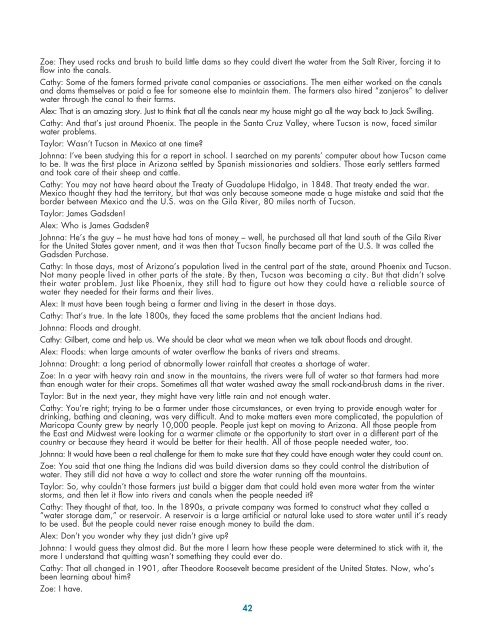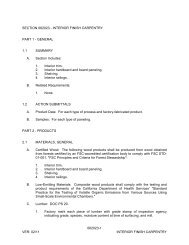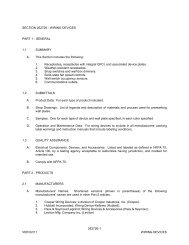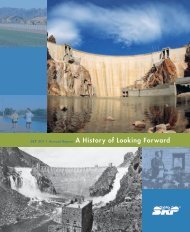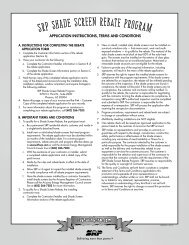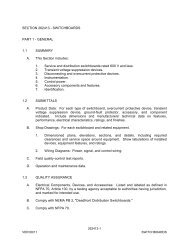LESSON 4: ARIZONA WATER STORY VIDEO - Salt River Project
LESSON 4: ARIZONA WATER STORY VIDEO - Salt River Project
LESSON 4: ARIZONA WATER STORY VIDEO - Salt River Project
- No tags were found...
Create successful ePaper yourself
Turn your PDF publications into a flip-book with our unique Google optimized e-Paper software.
Zoe: They used rocks and brush to build little dams so they could divert the water from the <strong>Salt</strong> <strong>River</strong>, forcing it toflow into the canals.Cathy: Some of the famers formed private canal companies or associations. The men either worked on the canalsand dams themselves or paid a fee for someone else to maintain them. The farmers also hired “zanjeros” to deliverwater through the canal to their farms.Alex: That is an amazing story. Just to think that all the canals near my house might go all the way back to Jack Swilling.Cathy: And that’s just around Phoenix. The people in the Santa Cruz Valley, where Tucson is now, faced similarwater problems.Taylor: Wasn’t Tucson in Mexico at one time?Johnna: I’ve been studying this for a report in school. I searched on my parents’ computer about how Tucson cameto be. It was the first place in Arizona settled by Spanish missionaries and soldiers. Those early settlers farmedand took care of their sheep and cattle.Cathy: You may not have heard about the Treaty of Guadalupe Hidalgo, in 1848. That treaty ended the war.Mexico thought they had the territory, but that was only because someone made a huge mistake and said that theborder between Mexico and the U.S. was on the Gila <strong>River</strong>, 80 miles north of Tucson.Taylor: James Gadsden!Alex: Who is James Gadsden?Johnna: He’s the guy – he must have had tons of money – well, he purchased all that land south of the Gila <strong>River</strong>for the United States gover nment, and it was then that Tucson finally became part of the U.S. It was called theGadsden Purchase.Cathy: In those days, most of Arizona’s population lived in the central part of the state, around Phoenix and Tucson.Not many people lived in other parts of the state. By then, Tucson was becoming a city. But that didn’t solvetheir water problem. Just like Phoenix, they still had to figure out how they could have a reliable source ofwater they needed for their farms and their lives.Alex: It must have been tough being a farmer and living in the desert in those days.Cathy: That’s true. In the late 1800s, they faced the same problems that the ancient Indians had.Johnna: Floods and drought.Cathy: Gilbert, come and help us. We should be clear what we mean when we talk about floods and drought.Alex: Floods: when large amounts of water overflow the banks of rivers and streams.Johnna: Drought: a long period of abnormally lower rainfall that creates a shortage of water.Zoe: In a year with heavy rain and snow in the mountains, the rivers were full of water so that farmers had morethan enough water for their crops. Sometimes all that water washed away the small rock-and-brush dams in the river.Taylor: But in the next year, they might have very little rain and not enough water.Cathy: You’re right; trying to be a farmer under those circumstances, or even trying to provide enough water fordrinking, bathing and cleaning, was very difficult. And to make matters even more complicated, the population ofMaricopa County grew by nearly 10,000 people. People just kept on moving to Arizona. All those people fromthe East and Midwest were looking for a warmer climate or the opportunity to start over in a different part of thecountry or because they heard it would be better for their health. All of those people needed water, too.Johnna: It would have been a real challenge for them to make sure that they could have enough water they could count on.Zoe: You said that one thing the Indians did was build diversion dams so they could control the distribution ofwater. They still did not have a way to collect and store the water running off the mountains.Taylor: So, why couldn’t those farmers just build a bigger dam that could hold even more water from the winterstorms, and then let it flow into rivers and canals when the people needed it?Cathy: They thought of that, too. In the 1890s, a private company was formed to construct what they called a“water storage dam,” or reservoir. A reservoir is a large artificial or natural lake used to store water until it’s readyto be used. But the people could never raise enough money to build the dam.Alex: Don’t you wonder why they just didn’t give up?Johnna: I would guess they almost did. But the more I learn how these people were determined to stick with it, themore I understand that quitting wasn’t something they could ever do.Cathy: That all changed in 1901, after Theodore Roosevelt became president of the United States. Now, who’sbeen learning about him?Zoe: I have.42


